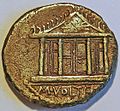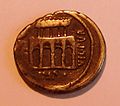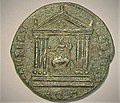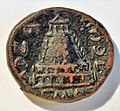List of Roman structures on ancient coins
The list of Roman buildings on ancient coins names buildings from Roman antiquity in chronological order that were depicted on the coins of their time. Temples and other public buildings and parts of buildings such as forums , theaters, docks, lighthouses, bridges, aqueducts , triumphal arches and columned monuments and larger altars are shown . Structural ensembles, such as the port of Ostia Antica on a sesterce of Nero, are rarer. The coins of the republic listed here name the catalog numbers for Albert. The coins of the Roman Empire are cited according to Kampmann, those of the cities in Asia Minor according to Varbanov or Sear. From around the middle of the 3rd century AD, temples are still depicted on Roman coins, but these are abstract and often highly stylized temples or fortifications. They are usually not assigned to any specific building. With the exception of the lighthouse of Alexandria, the Pharos, this also applies to Alexandrian coins such as the illustration of pylons .
Coins of the Roman Republic
- Aqua Marcia , equestrian statue on aqueduct, Denarius of Manius Aemilius Lepidus, 114 or 113 BC Minted (A. 1074)
- Ship houses of the port of Ostia , As des Gaius Marcius Censorinus , 88 BC Minted (A. 1211)
- Capitoline Temple , four-pillar temple of Jupiter Optimus Maximus, Denarius of Marcus Volteius Marci filius, 78 BC Minted (A. 1280)
- Temple of Jupiter Libertas on the Aventine , Denarius of Gaius Egnatius Maximus, minted 75 BC. BC (A. 1293)
- Basilica Aemilia in the Roman Forum, Denarius of Marcus Aemilius Lepidus , struck in 61 BC. BC (A. 1339)
- Temple of Vesta , round temple of Vesta in the Roman Forum, Denarius of Quintus Cassius Longinus , 55 BC. Minted (A. 1354)
- Villa publica , state guest house and recruitment office, Denarius of Publius Fonteius Capito , 55 BC Minted (A. 1357)
- Subsellium ( Rostra ), speaker's platform in the Roman Forum, Denarius of Lucius Lollius Palicanus, minted 45 BC. BC (A. 1460)
- Pharos of Messina , commemorates Pompey's sea victory over Octavianus before Bruttium , minted 42–36 BC. BC (A. 1559)
- Sanctuary of Venus Cloacina , Denarius of Marcus Aemilius Lepidus (Triumvir) , 42 BC. Minted (A. 1603)
- Temple of Neptune on the southern field of Mars , Denarius des Gnaeus Domitius Ahenobarbus , struck 41 BC BC (A. 1647)
- Picture gallery of coins of the Roman Republic with buildings
The sanctuary of Venus Cloacina on a Roman denarius , 42 BC. Chr., Crawford 494 / 42b
Coins of the Roman Empire
The increasing lack of structures in Rome on the coins since the time of the soldier emperors is also due to the fact that they were mainly busy on site with border security and the fight against counter-emperors. Some emperors of this time were never in Rome and could not take care of the further urban development.
- Iulia Curia , Denarius of Octavianus (Km 2.23)
- Actium arch , denarius of Octavianus on the victory of Actium (Km 2.25)
- Altar of Lugdunum, denarius of Tiberius (Km 5.13)
- Temple of Concordia (Rome) (Km 5.15)
- Temple of Janus , Sesterce of Nero (Km 14.34)
- Macellum , Dupondius des Nero (Km 14.33)
- A bird's eye view of the port of Ostia Antica , Sesterz des Nero (Km 14.40)
- Colosseum , Flavian amphitheater, Sesterz des Titus (Km 22.90)
- Trajan's Forum , aureus of Trajan (Km 27.12)
- Trajan's Column , Denarius of Trajan (Km 27.62)
- Bridge over the Danube, Sesterz des Trajan (Km 27.116)
- Temple of Jupiter, Dupondius of Trajan (Km 27.119)
- Antoninus Pius column made of consecration sesterce (Km 35.319), minted under Marcus Aurelius
- Temple of Mercury , Sesterce of Mark Aurel (Km 37.216)
- Circus Maximus , Sesterce of Caracalla (Km 51.171)
- Temple of Juno Martialis , Sesterce of Trebonianus Gallus (Km 83.35)
- Picture gallery of coins from the Roman Empire with buildings
Concordia Temple (Rome) on the back of the sesterce
Trajan's column on the reverse of the denarius of Emperor Trajan
Temple of Juno Martialis on Sesterce of Trebonianus Gallus , Kampmann 83.35
Roma temple on bronze coin of Maximianus Herculius , Kampmann 120.96
Roman provincial coins
The warlike conflicts with Germanic tribes and the Persian Empire, which intensified in the 3rd century, prompted many cities in the Roman dominion to build or expand city walls. The cities of Asia Minor then stamped their city gates as a motif on the back of their local bronze coins. Much more often temples are shown, mostly with four columns, but also with two to ten columns, occasionally with a statue of a deity in the temple.
- City gate of Nicopolis ad Istrum (Moesia) on bronze coin of the city z. Time of the emperor Elagabalus (Varbanov 3139 var.)
- City gate of Augusta Traiana (Thrace) on bronze coin of the city z. Time of the emperor Septimius Severus (Varbanov cf. 962)
- the Acropolis with the Parthenon on bronze coin Athens in the time between Hadrian and Antoninus Pius (Sear GIC Attica 4855)
- stylized labyrinth on bronze coin from Knossos (Crete) (Sear Augustus GIC 41)
- Ensemble of three temples on large bronze coins from Pergamon (Sear GIC Caracalla 2534, Severus Alexander 3296)
- the octagonal and closed city wall of Nicea (Bithynia) with two opposite city gates (Sear GIC Macrianus 4730, Quietus 4733)
- Bird's eye view of forum on large bronze coin from Laodicea ad Lycum (Sear GIC 2592)
- six-arched bridge over the meander on a large bronze coin from Antioch ad Maeandrum (Sear Gallienus 4568)
- Pharos of Alexandria , e.g. B. on AE of Hadrian (Kampmann / Ganschow 32,557 and 589 and 690). Although this is a lighthouse built in the Hellenistic period, it was also used in Roman times.
- The Serapis temple of Marcianopolis in Moesia on a bronze coin z. Currently Gordianus III. (Varbanov GIC 4228)
- the temple of Tyche of Antioch on the Orontes on 8 Assaria coin z. Currently Volusianus' (McAlee 1192/3)
The coins that were minted at the time of the Bar Kochba uprising, some of which show the Temple of Jerusalem (Sear 5647 - 5651), belong to the Roman provincial coins only in a broader sense .
- Picture gallery of Roman provincial coins with buildings
City gate of Nicopolis ad Istrum with an open rectangular passage
City gate of Augusta Traiana with three towers
City gate of Pomorie (Anchialus) z. Currently of the Gordian. III.
Temple on the mountain, Zeugma (city) z. By Antoninus Pius
Serapis temple Marcianopolis z. Currently of the Gordian. III.
City gate Marcianopolis z. By Macrinus and Diadumenianus
Tyche temple Antioch on the Orontes z. Of Volusianus
literature
- Rainer Albert : The coins of the Roman Republic. Regenstauf, 1st edition 2003.
- Ursula Kampmann : The coins of the Roman Empire. Regenstauf, 1st edition 2004.
- Harald Küthmann , Bernhard Overbeck : Buildings of Rome on coins and medals - Exhibition of the State Coin Collection Munich from October 16 to December 2, 1973.
- Martin Jessop Price , Bluma L. Trell: Coins and their cities - Architecture on the ancient coins of Greece, Rome, and Palestine. London 1977, ISBN 0-8143-1586-0 .
- David R. Sear : Greek Imperial Coins and their values - The Local Coinage of the Roman Impire London 1982, Reprinted 2010, ISBN 978-0-900652-59-2 .


















